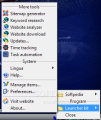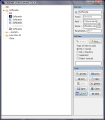Launchers are applications that help the user access shortcuts, files, folders, and websites much easier. They are designed to improve the daily work flow by shortening the time to launch a specific item location. With the help of keystrokes, or just through a few mouse clicks, you will be able to eliminate the long process of finding the location you need or application to start. Sure, there are other available methods that you can use instead of launchers, and here I mean desktop, quick launch, or system tray shortcuts, but if the number of files to be launched is large, then you will indeed have a problem.
The application in test is called Micro-Sys Launcher. The software was designed to be a small and simple solution that would help the users access their favorite files and folders. By default, Launcher comes with a few shortcuts that cannot be deleted, which are present in the More Tools menu.
Here, you can find a list of a few other programs that the developer owns. Starting from the 1.6.0 version, the tool has been divided in two: “Launcher 'Free' as freeware, and continues to get bug fixes, and Launcher 'Pro' as shareware, and will get further development” (according to the version's history file). So, I believe that the More Tools menu will only appear in the free version.
Adding items to Launcher’s list is as easy as it gets. The first method you can use is to simply drag and drop shortcuts on the top of the items' tree structure. The second variant is to find the shortcut to add, set the items parameters, and select the location. One initial test that I made was to create a “virtual folder” and store a few items there. The task was simple. As items, Launcher also provides separators and virtual directories, besides files and folders. The Separators and Virtual Folders options can be used to separate and define shortcut categories.
An important aspect after adding items to the list is to press the Save button before closing the Item Manager window. For every shortcut, the application lets the user modify its parameters (e.g. name, path, etc.). All item savings are stored within the root folder, in the Shortcuts directory. If the number of items that you add will increase and you will forget the details related to every one of them, you can use the Sweep button to check for invalid shortcuts.
After installation, Launcher will register itself in Windows startup. Whether you want to keep it that way or not is your choice. The utility can be activated from the system tray, by means of the default CTRL+L key combination (which can be changed from the Options window), or by using the system tray icon.
A small test shows that Launcher will snap to your mouse position, showing the items list from where you can select the ones to access. The tool can also be used from portable drives (CD, DVD, and USB Drive), nevertheless there is a small correction that needs to be made. First of all, the software also creates folders in My Documents and Application User Data, so it's somewhat not fully portable.
Then, to make it run from portable drives, you will need to edit the “muc.ini” file from the root directory. To add shortcuts that are stored on portable drives, again, you need to make certain adjustments. From the Item Manager window, the path parameter must be changed for the portable items. Instead of inserting the partition letter and path, you will need to enter “..\location\sample.exe” (some pointers are provided by the developer in the Help file).
So as to back up all the items and configuration savings, you must copy the Shortcuts folder from the root directory. One thing that needs to be mentioned here is that if shortcuts are somehow not properly set, a folder named “item_bak” will be created.
The user interface of the Micro-Sys Launcher application consists of the system tray menu, from where you can access your shortcuts, and of the floating one that snaps to your mouse position, when called upon. From the Options window you will be able to set the font size and program behavior. The default language for the user interface is English, but it can also be changed from the system tray menu to German, Spanish, France, Italian, Romanian, or Russian. The User Interface Persistence tab provides two options to save window and miscellaneous setups.
The Good
I was glad to discover that Micro-Sys Launcher can also be accessed from portable drives, and that it remembers relative paths. The “snap to mouse position” function implemented to this utility does help a lot, both when using it in a multi-monitor environment, and in simple desktop one.
The Bad
The Truth
Micro-Sys Launcher application offers simple ways to launch both your shortcuts and portable items. After a few changes are implemented, you can make it run from portable drives and remember relative paths.
Here are some snapshots of the application in action:
 14 DAY TRIAL //
14 DAY TRIAL // 




